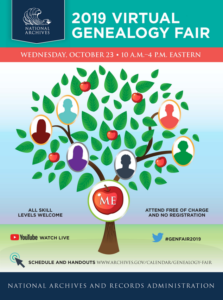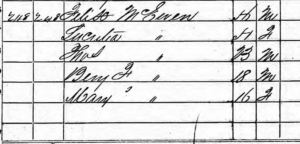 This one really snuck up on me.
This one really snuck up on me.
The 2019 Virtual Genealogy Fair is being offered (free of charge) by the National Archives and Records Administration (NARA) tomorrow, Wednesday, October 23, 2019. This is the seventh year for the conference, offered by webcast on YouTube. It’s a wonderful resource.
You can read the lineup, with detailed descriptions of the sessions and links to handouts, here. Just click on each session title to access the handouts. There will be six one-hour sessions, bookended by opening and closing remarks. The event starts at 10 am eastern and ends at 4.
I’m traveling tomorrow, so I was thrilled to read that I don’t have to watch live. The webcast will be available on YouTube to watch later. You can even request transcripts of the sessions, taken from the closed captioning.
While you’re on the 2019 Virtual Fair webpage, scroll down to access links to prior Virtual Genealogy Fairs sponsored by NARA. Those are available to watch as well!



